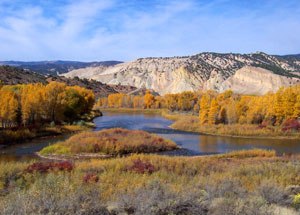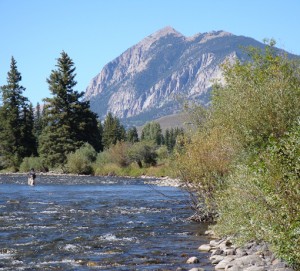A new study just released from the University of Colorado, published in the peer-reviewed journal Molecular Ecology and funded in part by Trout Unlimited, will redraw the map on Colorado's native cutthroat trout and has shone a spotlight on a small tributary of the Arkansas River near Colorado Springs.
The study, conducted using historic fish samples from the 19th Century, attempted to shed light on what native trout lineages were found in Colorado - and where they were found. Among the most notable findings: the fish generally believed to be greenback cutthroat trout and native to the Front Range are in reality from native trout lineages west of the Contintental Divide, while one remaining greenback population remains in Bear Creek on the flanks of Pikes Peak. Trout Unlimited is actively working to protect habitat and address issues with trail impacts and sedimentation in Bear Creek.
The Denver Post has reported on the study and its implications for cutthroats and for Bear Creek. Trout Unlimited also issued a press release on the study.
Does this mean that the work done to date on greenback restoration is for naught? Fortunately, that is not the case. First - the restored populations are still valuable native Colorado trout albeit of a different lineage and their conservation is important, just as is that of the greenbacks themselves. Moreover, work that has been done in preparing sites for successful relocations (such as planning efforts in the Poudre headwaters for large-scale greenback restoration) as well as general TU efforts in improving habitat and watershed health, will help create a better home for the greenbacks in those locations where they are reestablished going forward. Our work to date provides a solid foundation for our future restoration efforts with the greenback.
Of course having to push the "reset" button on our native trout restoration strategies is a disappointment, but the flip side of any disappointment is opportunity. It has been said that "extinction means it is too late." The good news for greenbacks is that we are not too late and our efforts in the years to come will help ensure that our children and grandchildren can have the opportunity to fish for this unique Colorado native.
Q&A about the new genetics study on Colorado’s native cutthroat trout
What are the key findings from the new University of Colorado genetics study?
By looking at DNA from historic fish samples as well as stocking records, the study’s authors – led by principal investigator Dr Jessica Metcalf – have identified six different genetic lineages of native trout for Colorado (compared to the four previously identified) and have in some cases suggested that the lineages have a different historic range than was previously thought. Specifically, they identify lineages for the Arkansas drainage (Yellowfin – now believed extinct), the South Platte drainage (Greenback – now found in one small stream in the Arkansas basin, Bear Creek), the Rio Grande drainage (Rio Grande), the Green/Yampa basins (Colorado River), the Colorado/Gunnison basins (previously unnamed), and the San Juan basin (previously unnamed – now believed extinct).
So if there’s only one population left in the Arkansas basin, then what are the “greenbacks” I’ve caught in places like Rocky Mountain National Park?
Based on the genetic markers identified by Dr. Metcalf and her colleagues, it appears that most such populations are likely a different Colorado native trout – from either the Green/Yampa lineage or the Colorado/Gunnison lineage. So you have caught a real Colorado native – just not a greenback.
Can I catch a true greenback in Bear Creek?
No. Because the population is small and susceptible to hooking mortality, it has been – for several years – closed to fishing. We hope that as new sites are restored with these fish that anglers will again have the opportunity to fish for native greenback cutthroat trout.
Does this mean that the fish previously thought to be greenbacks are no longer protected under the Endangered Species Act?
No. The U.S. Fish and Wildlife Service will be initiating a review of cutthroat trout in Colorado to examine the genetic results as well as results from an ongoing study looking at physical characteristics of the different fish and any other relevant science. To assist in that process, they will convene a group of leading experts in the field to help advise them on proper classification among the different cutthroats – and on the question of which lineages are imperiled and warrant continued Endangered Species Act protection. From those results, they will then begin a formal rulemaking process to make any changes. Until that rulemaking takes place, all populations previously protected as “greenbacks” will remain protected under the Endangered Species Act.
What is TU doing to protect the one remaining greenback population in Bear Creek?
The one population of greenbacks still known to exist are found in Bear Creek near Colorado Springs – ironically, the result of an early stocking effort by a local hotelier that believed that cutthroat fishing would help draw tourists. The Bear Creek watershed is suffering from sedimentation and the impacts of both motorized and non-motorized trails, as well as from an existing gravel road (High Drive) that parallels the lower part of the stream. Trout Unlimited, with leadership from our local Cheyenne Mountain Chapter and in partnership with federal, state, and municipal agencies and local stakeholders, is working on volunteer projects to help address sediment impacts and to rehabilitate unauthorized user-created trails that are impacting the stream. At the same time, Trout Unlimited has reached out to mountain bikers and motorbike users to collaborate on assessing and relocating sections of trail that are creating impacts on the stream. With support from this diverse group of stakeholders, the Forest Service is currently completing a trails assessment that will clearly identify problem sections of trail and options for relocating those sections away from Bear Creek to eliminate those impacts. We anticipate work will begin on trail relocation in 2013. We also applaud CH2MHill, which is donating its services for a road assessment on High Drive to help guide efforts to modify the road so as to reduce its significant impacts on sedimentation in the lower reaches of the cutthroat habitat. We are working with the Forest Service and other partners to seek funding for road improvements as well.
So what will be the future for greenback restoration? Will populations of the Colorado/Gunnison fish be removed and replaced?
That decision will rest with the Colorado Division of Parks and Wildlife and the U.S. Fish and Wildlife Service, along with their agency partners on the Greenback Recovery Team. Fish from the Bear Creek lineage are now being raised in multiple hatcheries for restocking into appropriate waters, and we expect that efforts to establish new populations using those fish will take place fairly soon. There are locations that have been identified as potential restoration sites that could be used in this effort without removing cutthroats from previously “restored” waters, and those may be the logical first places to move with restoration. That will provide the agencies with more time to come up with answers for the long-term question of what to do with cutthroats that have been re-established in waters outside their native range.














